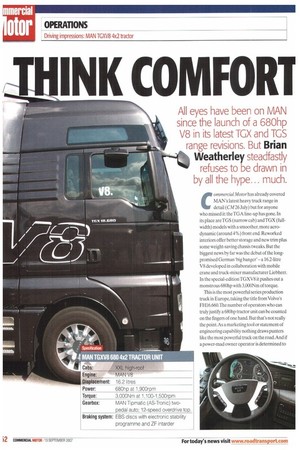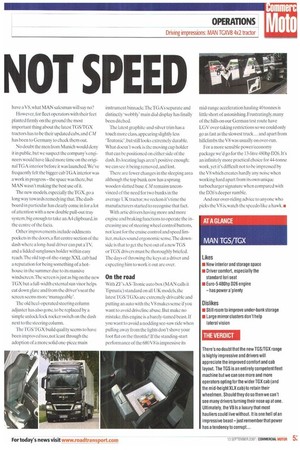NK COMFORT NOT SPEED
Page 52

Page 53

If you've noticed an error in this article please click here to report it so we can fix it.
All eyes have been on MAN since the launch of a 680hp V8 in its latest TGX and TGS range revisions. But Brian
Weatherley steadfastly
refuses to be drawn in by all the hype... much.
Commercial Motor has already covered MAN's latest heavy truck range in detail (CM 26 July) but for anyone who missed it: the TGA line-up has gone. In its place are TGS (narrow cab) andTGX (fullwidth) models with a smoother, more aerodynamic (around 4%) front end. Reworked interiors offer better storage and new trim plus some weight-saving chassis tweaks. But the biggest news by far was the debut of the longpromised German `big banger' — a 16.2-litre V8 developed in collaboration with mobile crane and truck-mixer manufacturer Liebherr. In the special-edition TGXV8 it pushes out a monstrous 680hp with 3,000Nm of torque.
This is the most powerful series production truck in Europe, taking the title from Volvo's FH16.660.The number of operators who can truly justify a 680hp tractor unit can he counted on the fingers of one hand. But that's not really the point.As a marketing tool or statement of engineering capability nothing draws punters like the most powerful truck on the road.And if a power-mad owner operator is determined to have a V8, what MAN salesman will say no?
However, for fleet operators with their feet planted firmly on the ground the most important thing about thelatestTGS/TGX tractors has Lobe their updated cabs, and CM has been to Germany to check them out.
No doubt the men from Munich would deny it in public, but we suspect the company's engineers would have liked more time on the original TGA interior before it was launched.We've frequently felt the bigger cabTGA interior was a work in progress — the space was there, hut MAN wasn't =king the best use of it.
The new models, especially the TGX, go a long way towards remedying that.The dashboard in particular has clearly come in for a lot of attention with a new double pull-out tray system, big enough to take an A4 clipboard, in the centre of the facia.
Other improvements include oddments pockets in the doors, a flat centre section of the dash where a long-haul driver can put aTV, and a lidded sunglasses holder within easy reach.The old top-of-the-range xxL cab had a reputation for being something of a hothouse in the summer due to its massive windscreen.The screen is just as big on the new TGX but a full-width external sun visor helps cut down glare and from the driver's seat the screen seems more 'manageable'.
The old heel-operated steering column adjuster has also gone, to be replaced by a simple unlock/lock rocker switch on the dash next to the steering column.
The IGS/TGX build quality seems to have been improved too, not least through the adoption of a more solid one-piece main instrument binnacic.TheTGA's separate and distinctly 'wobbly' main dial display has finally been ditched.
The latest graphite-and-silver trim has a touch more class, appearing slightly less 'Teutonic', but still looks extremely durable. What doesn't work is the moving cup holder that can be positioned on either side of the dash, its locating lugs aren't positive enough; we can see it being removed, and lost.
There are fewer changes in the sleeping area although the top bunk now has a sprung wooden slatted base. CM remains unconvinced of the need for two bunks in the average UK tractor; we reckon it's time the manufacturers started to recognise that fact.
With artic drivers having more and more engine and braking functions to operate the increasing use of steering wheel control buttons, not least for the cruise control and speed limiter, makes sound ergonomic sense.The downside is that to get the best out of a newTGS or TGX drivers must be thoroughly briefed. The days of throwing the keys at a driver and expecting him to work it out are over.
On the road With ZF's AS-Tronic auto box (MAN calls it Tipmatic) standard on all UK models, the latestTGS/TGXs are extremely driveable and putting an auto with the V8 makes sense if you want to avoid driveline abuse. But make no mistake, this engine is a barely-tamed beast. If you want to avoid a nodding see-saw ride when pulling away from the lights don't shove your foot flat on the throttle! If the standing-start performance of the 680 V8 is impressive its mid-range acceleration hauling 40 tonnes is little short of astonishing. Frustratingly, many of the hills on our German test route have LGV over-taking restrictions so we could only go as fast as the slowest truck... and apart from hillclimbs the V8 was usually on over-run.
For a more sensible power/economy package we'd go for the 13-litre 480hp D26.It's an infinitely more practical choice for 44-tonne work, yet it's difficult not to be impressed by the V8 which creates hardly any noise when working hard apart from its own unique turbocharger signature when compared with the D26's deeper rumble.
And our over-riding advice to anyone who picks the V8 is, watch the speedo like a hawk.•




























































































































































































